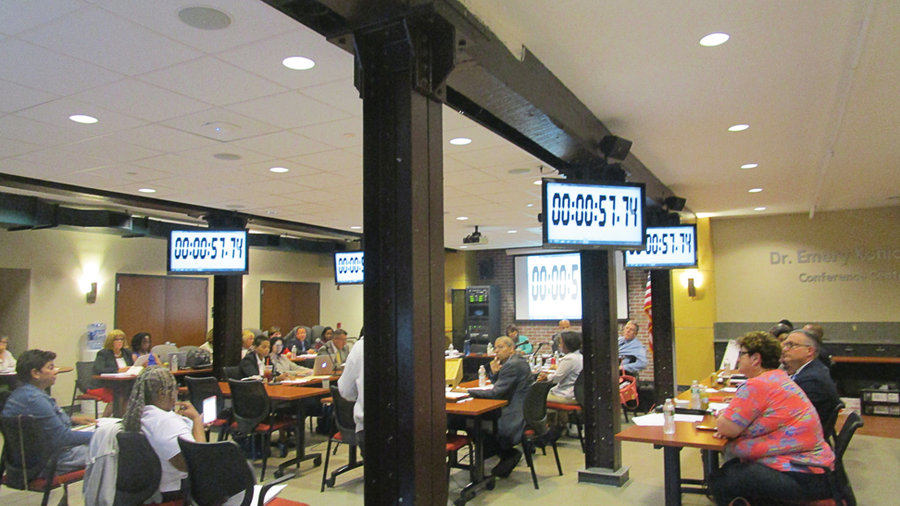To answer community outrage over the location of a prisoner reentry center near a school in Ward F, the City Council adopted an ordinance on Sept. 9 that tightens rules for establishing such facilities. But despite the new procedures, residents and the Board of Education still insist the city administration must be more forthcoming.
Residents in Ward F – considered the poorest section of the city – also said they want increased notice and a limit on the number of such programs that can be established in their neighborhood.
The resolution came after Martin Luther King Drive residents learned that a satellite of the nearby Martin’s Place prisoner re-entry program had been located next to a charter school. The center, since closed, had just begun operations in a former priory at Sacred Heart Church, and offered employment training, legal help, and other services to former prison inmates.
The short-lived Community Resource Center at Sacred Heart was also intended to provide assistance with job placement, housing referrals, and addiction and mental health treatment to ex-offenders from across Hudson County.
The new facility was built with inmates from the Hudson County Correctional Facility doing much of the restoration work.
Organizers were apparently unaware that this facility was located near a charter school. Jim McGreevey, director of Work Force Development for the city, said another site is being sought.
“We don’t want people hanging out on the steps staring at our kids.” – Monique K. Andrews
____________
Community wants more safeguards
“We don’t want people hanging out on the steps staring at our kids,” said Monique K. Andrews during the public session of the council meeting when the ordinance was adopted.
Residents said they were never notified about the program that brought former inmates into areas that included schools, parks, and day care centers.
Parents and other residents said this isn’t the only time this has happened, either. While Martin’s Place, at 398 Martin Luther King Drive, received a lot of attention when it opened last year, other small halfway houses have cropped up in Ward F, some of which had been relocated out of the Journal Square area.
The residents suggested the centers might have been displaced by new upscale development booming in the Journal Square area.
Residents had also asked for better communication from the city. In answer, the new ordinance requires that the program notify the city business administrator and the city clerk who would then notify council members and residents 30 days before an opening. Residents had demanded a 90 day warning period to better mobilize against the program if they see a problem.
“We need six months just to be able to create a dialogue,” said former Councilwoman Viola Richardson. “This will allow us to keep coming back here if we have to.”
City Attorney Jeremy A. Farrell said the city is limited on the kind of restrictions it can impose on private property. Some of the restrictions residents called for would likely require a zoning change, governed by the city Planning Board.
“We can preclude certain uses,” he said. “But we can’t be overly broad.”
Even council members say they didn’t know
Councilwoman Diane Coleman said she was not aware of the program near the school until the day officials cut the ribbon.
“People started blaming me, and even protested outside my house,” she said.
Richardson blasted Coleman, saying she should have known what was going on in her ward.
“If the job is too much for you, then resign,” Richardson said. “You are responsible for whatever programs come into your ward. You were at the ribbon cutting. You even spoke there.”
Resident Joan Terrell questioned some of the work that went on at the proposed halfway house, noting that city employees were used.
Kabili Tayari agreed that the city needed to impose restrictions that did not violate the law. But he said communication with the largely African-American community is not what it should be, noting that in wealthier neighborhoods such as Paulus Hook, Van Vorst Park, and Hamilton Park there would have been a lot of discussion.
“All we’re asking for is to be included,” he said, suggesting that the city ordinance require meetings with the community. “We need something that says the community will be engaged like it is in the wealthy part of the city.”
Councilwoman Candice Osborne agreed that meetings of this kind would take place in Ward E which she represents.
“But they’re not codified,” she said. “Those meetings happen because I did them on my own. Other council people didn’t know about this.”
Coleman said if she had known this program was being put in next to a school, she would have done something about it.
“I heard rumors that others are creeping into our community,” she said. “Two programs are funded by the city, but there was no disclosure that they were moving into Ward F.”
She suggested that council might cut funding if notice is not given to the community, giving the governing body some way to control the situation.
School officials also concerned
The re-entry center was an issue even after the ordinance’s passage. At the Sept. 15 Board of Education caucus meeting parents and trustees asked about possible warnings over new halfway houses near schools.
“Can’t we create safety zones for our children?” asked Gina Verdibello, a parent and a candidate in this year’s Board of Education election.
Dr. Marcia Lyles, superintendent of schools, said she’d had conversations with Councilwoman Joyce Watterman over the issue of installing reentry centers in proximity to schools.
“We’re really concerned about the latest,” Lyles said, referring to one that had been located at Sacred Heart Church. “We’re trying to determine how these sites came into the area. The issue seems to be more pervasive than led to believe.”
She said the city needs to tell the Board of Education where these sites are located.
Al Sullivan may be reached at asullivan@hudsonreporter.com.
